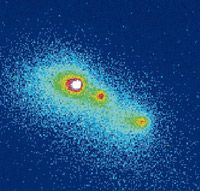
Comet Schwassmann-Wachmann 3 on January 31, 1996, after it broke into three pieces in late 1995. This false-color image was made with the 3.5-meter New Technology Telescope at La Silla, Chile. Fragments A, B, and C had spread out to span 17 arcseconds along the comet's line of flight. Read the comet's history.
Courtesy European Southern Observatory.
May 19th: We're just past the peak of what has been a fascinating apparition of Periodic Comet Schwassmann-Wachmann 3 (also known as Comet 73P), featured starting on page 60 of the May 2006 Sky & Telescope.
Two fragments of the disintegrating comet are visible in binoculars and small scopes at about 7th magnitude, a third has been in reach of large amateur scopes — and 63 much fainter pieces have been tracked. All are strung in a straight line. They've just made their closest pass by Earth, at a distance of only 10 million kilometers (6 million miles), and are still not much farther. This month and next they're about as close to the Sun as they will get (0.94 to 1.0 astronomical unit). They're currently visible in the eastern sky just before the first light of dawn.
The comet broke apart in 1995, and the process continues. The brightest chunks are Fragments C and B, the latter of which has been remarkably active. It's following behind and north of C. Next brightest is R, about 13th magnitude and north of B. The rest are much fainter.
The pieces are still nearly at their brightest — though less bright (at least in the case of Fragment C) than originally hoped.
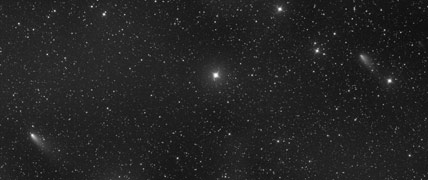
A double comet! Fragment C of Comet Schwassmann-Wachmann 3 is at left, and slightly fainter B is at right. In the full-resolution image, much fainter G is dimly detectable to the right of B (by about 1/6 of the separation from B to C). Gerald Rhemann and Michael Jäger made this composite panorana on April 22nd using a 300mm f/4 lens on a FLI 6303E CCD camera.
Image by Gerald Rhemann and Michael Jäger.
Here's the ongoing news. Skip to the end for the latest news, and for links to current finder charts.
April 3: Fragment B is in a flareup! Czech observer Kamil Hornoch first noticed that B was brighter than expected, observing it at magnitude 11.1.
Longtime comet observer John Bortle writes: "I had observed the B and C comets on March 28/29, with the former appearing as just a small, faint and generally diffuse spot of magnitude 12.5 at the predicted position. When next observed, on April 3.15 UT, it had changed dramatically in character. Instead of a diffuse spot, in its place was a fine, bright "star" of magnitude 10.8 , surrounded by a little haze."
April 5: Bortle's observations from last night: "The outburst dust shell [of B] is rapidly expanding. It is now about 1.2 arcminutes in diameter. . . . the comet appears almost starlike [at magnitude] 10.7. Component C is 9.7."
April 6: Both C and B are now of similar brightness. German amateur Maik Meyer writes on the Comets-ml mailing list: "I have just observed 73P-B and C and was surprised to find B much more easily visible. It is almost starlike with a faint outer halo compared to C, which is much more diffuse and is one reason for the better visibility. However, I find both components almost equal in brightness [B = 9.5, C = 9.6]."
April 10: From John Bortle: "In spite of the bright moonlight, both B and C were clearly visible with 20x100 binoculars last evening (April 10.14 UT). The C component had an integrated magnitude of 9.0, while B was just a tenth of a magnitude brighter. B's coma was smaller (2.2' vs. 3.1'), so its resulting higher surface brightness made it the easier of the two to pick out against the bright sky background. Since they are now only 0.3 a.u. from Earth, it is quite unusual that their comae appear so compact."
April 11: Many observers report more signs that Fragment B is breaking up. Carl Hergenrother, observing with the 1.2-meter SAO telescope, says "a sharp central condensation is no longer visible in my images. The central condensation is now a diffuse bar about 8 arcseconds in length. . . ."
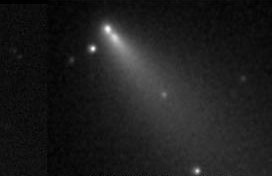
By April 24, 2006, Component B had split into two pieces about 12 arcseconds apart. P. Clay Sherrod used a CCD camera on a 0.41-meter Ritchey Chretien telescope for this image at 5:27 UT. North is up.
Photo by P. Clay Sherrod.
April 24: Fragment B has indeed split into two pieces, as seen in the photo here. They were about 12 arcseconds apart as of April 24th, aligned in the direction of B's tail, and gradually drifting farther away from each other. Their combined magnitude remains around 9.
Meanwhile, Component C has not been brightening as fast as predicted; it was about magnitude 8.5 as of April 19th instead of 6.9 as predicted in the May Sky & Telescope. So it may not get near the hoped-for 4th magnitude when it's closest to Earth in mid-May. Component G is 11th or 12th magnitude, and R is 14th or 15th.
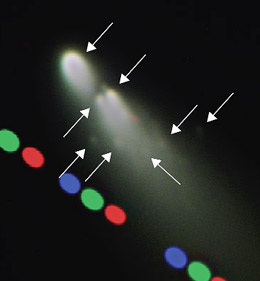
The crumble continues. This closeup image of Fragment B (digitally enhanced) was taken by the European Southern Observatory's Very Large Telescope on April 23–24, 2006. Arrows mark subfragments.
Courtesy European Southern Observatory.
April 25: Fantastic new pictures showing further breakup of B! The Very Large Telescope of the European Southern Observatory imaged Fragment B on April 23–24; the pictures are displayed and explained in an ESO press release.
April 27: B has brightened up again. Last night P. Clay Sherrod estimated it at magnitude 8.3 compared to 7.9 for C. On the other hand, observing visually with a small, 66-mm refractor through light pollution over Boston, Sky & Telescope's Tony Flanders called C "moderately easy" but called B "very hard."
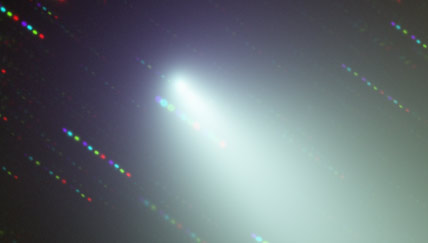
A less processed, more natural, wider-field version of the VLT image.
Courtesy European Southern Observatory.
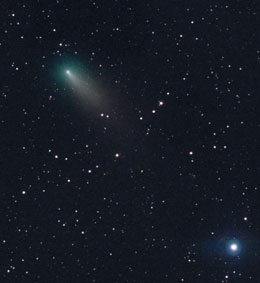
On the morning of April 27th, S&T's's Sean Walker imaged Fragment B with a 66-millimeter refractor under the dark skies of Chester, New Hampshire. He used an ST8XE CCD camera for a 10-minute exposure in each color. The bright star is Theta Coronae Borealis. North is up.
S&T; Sean Walker.
Meanwhile, more disintegration continues. Using the Vatican Observatory 1.8-meter telescope in Arizona on April 27.33, Carl Hergenrother took images showing that the third-place chunk, 12th-magnitude Fragment G, has itself crumbled into at least 15 pieces while brightening somewhat overall.
And fourth-place Fragment R has also shown a suspicious brightening, to 14th magnitude.
Astronomers at the Space Telescope Science Institute have released Hubble Space Telescope images of B and G both disintegrating as seen on April 18th.
May 1, from John Bortle: "The C component continues to increase in apparent size and brightness almost nightly. On May 1.11 UT it was an obvious binocular object with 10x50 binoculars just east of Zeta Herculis. Roughly similar in size to nearby M13 but about a magnitude fainter, with a total magnitude of 6.9, its strongly condensed coma was nearly 12 arcminutes in size. Larger 20x100 binoculars showed a flowing tail 1° in length.
"Telescopically, 73P-C now appears like a large comet in miniature, with an intense pseudo-nucleus and a long, sweeping, tail extending beyond the edge of the eyepiece field. There have even been several reports in recent days that this object can be glimpsed with the unaided eye as a 'soft 6th-magnitude star' under very dark skies.
"In nearby Corona Borealis, the fragmented component B is growing rather more diffuse, but its dimensions continue to slightly exceed those of C. Last evening the coma's diameter was between 12' and 13', but this comet's more modest condensation, and the fact that at 7.4 it was half a magnitude fainter than C, made it less impressive with binoculars. Telescopically, B showed a moderately bright pseudo-nucleus and a stubby tail, lacking any definite indication of the numerous, tiny, subsidiary nuclei so dramatically illustrated in recent Hubble images.
"The whole situation is very reminiscent of the 19th century's famous Periodic Comet Biela. It split in two probably about 1840 and in both 1846 and 1852 was seen as a double comet, the components slowly drifting apart with time. It ultimately disintegrated completely. . . just as we are witnessing with 73P this time around!"
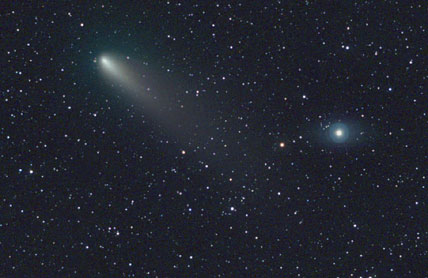
Fragment C displays a classic aquamarine-green gas coma, along with a redder dust tail, in this CCD image taken by Sky & Telescope's Sean Walker on the morning of April 29th. This view is about 80 arcminutes wide.
S&T; Sean Walker.
May 4: Fragment B continues to change rapidly; there are reports that it has started fading again and is becoming more diffuse. P. Clay Sherrod calls it magnitude 7.7, with signs of a double nucleus at high power. Bob King says that using a 10-inch scope at 357x, "I resolved a compact cloud or condensation immediately following the nucleus of B that made the nuclear region look like a very close, fuzzy double star."
C is about magnitude 7.0, B is about 7.5, G is 12, and R is 13 or 14.
May 9: C is about magnitude 6.2, B is about 6.8, G is fainter than 13 (apparently disintegrated), and R is 13.3. Fragments C and B have tails about 1° and ¾° long, respectively.
The nucleus of B has rebrightened in the last few days, and jets in its coma are now showing up in images. Unlike B and G, C has displayed no sign of breakup.
May 10: B continues brightening and now appears 5th magnitude, outshining C! It's also more condensed (concentrated toward its center), so it shows well through the moonlight. In a telescope, look for spikes and sunward hoods.
May 11: B is fading back down; binocular observers are reporting it appearing fainter than C again, though moonlight complicates the picture.
May 15: As the comets pass closest by Earth, telescopic observers are reporting that they can see real-time motion against the background stars. This week all the pieces are moving nearly 6° per day; that's 15 arcminutes per hour, or 15 arcseconds per minute of time!
May 17: P. Clay Sherrod writes that B is now magnitude 7.6, with (in a telescope) a "very pronounced string of fragments in the trailing direction [westward, opposite the direction toward the Sun] from the primary nucleus. In addition there is a very diffuse and large fragment seen to the NW of the primary comet." Others report that B may be in yet another flareup and seems to be outshining C again, though the moonlight makes their brightnesses hard to judge.
Component C, Sherrod writes, is "showing a beautiful 'dumbbell' shaped nebulous coma surrounding a very bright nucleus. Very unusual symmetry to the central region of this object, particularly on the sunward side of the nucleus."
May 19: Moonlight is lessening as the Moon wanes, though on the other hand, the Moon is getting closer to the position of the comet in the sky — and the comet pieces themselves are rapidly getting lower in the east before dawn. If you're in mid-northern latitudes, the comet won't be in view much longer.
From P. Clay Sherrod: Yesterday morning (May 18th) the string of fragments just behind the nucleus of B was no longer seen. But this morning (May 19th), B showed a double nucleus again! The two parts were almost equally bright. Clearly B continues busting up. Sherrod noted a slight sunward spike in the coma yesterday morning, but this morning it was missing.
Meanwhile, C continues to show its odd "hourglass" shape telescopically, with a broad tail in one direction and a broader sunward fan in the opposite direction.
A few days ago, Palomar Observatory released a dramatic movie of Fragment R, along with several smaller fragments in the comet line, speeding as a group across the starry background.
Most dramatic is the recent Spitzer Space Telescope image of the entire line of dusty comet debris glowing at mid-infrared wavelengths. The comet line is a new meteor stream in the making; the debris will continue to spread out along the comet's orbit in years and centuries to come.
Meteor shower May 22–23?
Jack Drummond of the Starfire Optical Range predicts that debris shed by the comet many years ago (long before the 1995 breakup) could bring us a meteor shower on the night of May 22–23. He writes:
"The closest approach of [Fragment C's] orbit to the Earth, 0.04 astronomical unit, occurs on May 22 at 20:00 UT. Thus the maximum of the meteor shower would be on May 22 or May 23, with a radiant of right ascension 208° [13h 52m] and declination +30° [in Canes Venatici, 12° north-northwest of Arcturus], and a geocentric velocity of 13.5 km/sec, which is quite slow." Unlike with many meteor showers, this radiant is highest in the sky as early in the night as 11 p.m. daylight saving time — so the meteors would be visible any time from dusk to dawn.
If the shower does peak around 20:00 May 22 Universal Time, that would be during the evening of the 22nd for continental Europe, later at night for western Asia, and before dawn on the 23rd for Central and South Asia. But keep watch wherever you are; the shower, if any, could arrive many hours earlier or later than that.
Where to Find the Comets
The whole comet train is currently (May 19th) more than 10° long, sidling across Pegasus — into Pisces and highest in the east just before the first light of dawn. (You can find the time when morning twilight begins at your site by checking that your location and time zone are correct in our online almanac. If you're on daylight saving time, like most of North America, make sure the Daylight Saving Time box is checked; if not, check it and and hit "Go" next to it.)
Use the chart in the May Sky & Telescope, page 62, for bright Fragment C. Fragment B is currently (May 19th) about 7° north of it.
See detailed finder chart for C, B, G, and R (courtesy Skyhound).
Or see simpler finder charts for the mornings of
from Spaceweather.com. Charts may not become live until the day before.
The waning Moon is last quarter on the morning of the 20th and is completely gone from the pre-dawn sky by about the 24th.
Keep checking here for news.
 0
0
Comments
You must be logged in to post a comment.